
 Contents Contents
  What are TRMM and GPM? What are TRMM and GPM?
  TRMM publications TRMM publications
  Kwajalein Ground Validation (opens new page) Kwajalein Ground Validation (opens new page)
  KWAJEX (opens new page) KWAJEX (opens new page)

  GPM publications GPM publications
  OLYMPEX publications (opens new page) OLYMPEX publications (opens new page)
|
What are TRMM and GPM?

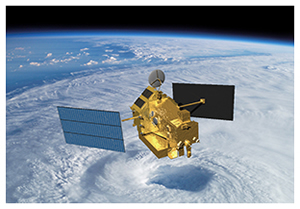 The Tropical Rainfall Measuring Mission (TRMM) was a joint mission between NASA and the National Space Development Agency (NASDA) of Japan to study tropical rainfall and the vertical gradient of heating caused by precipitating cloud systems. The TRMM satellite was launched 27 November 1997 in an orbit between 35S and 35N latitudes. It continued its mission in orbit until 15 April 2015. The instrumentation on board TRMM included a Ku-band radar, the first-ever quantitative spaceborne Precipitation Radar (PR). The Tropical Rainfall Measuring Mission (TRMM) was a joint mission between NASA and the National Space Development Agency (NASDA) of Japan to study tropical rainfall and the vertical gradient of heating caused by precipitating cloud systems. The TRMM satellite was launched 27 November 1997 in an orbit between 35S and 35N latitudes. It continued its mission in orbit until 15 April 2015. The instrumentation on board TRMM included a Ku-band radar, the first-ever quantitative spaceborne Precipitation Radar (PR). 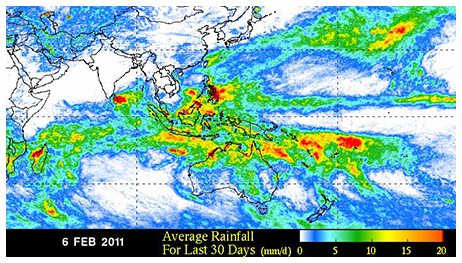 Onboard TRMM also was a multi-channel passive Microwave Radiometer (TMI), a Visible and Infrared Scanner (VIRS), a Cloud and Earth Radiant Energy System (CERES), and a Lightning Imaging Sensor (LIS). The TMI operated with five channels (10.65, 19.35, 21.3, 37.0, and 85.5 GHz), which allowed precipitation detection over both land and ocean. Onboard TRMM also was a multi-channel passive Microwave Radiometer (TMI), a Visible and Infrared Scanner (VIRS), a Cloud and Earth Radiant Energy System (CERES), and a Lightning Imaging Sensor (LIS). The TMI operated with five channels (10.65, 19.35, 21.3, 37.0, and 85.5 GHz), which allowed precipitation detection over both land and ocean.
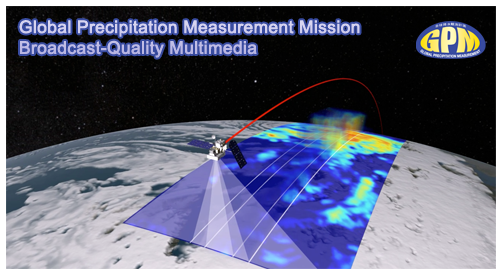 Succeeding TRMM is the Global Precipitation Measurement (GPM) Core Observatory satellite, launched 27 February 2014. Whereas TRMM was restricted to the tropics and subtropics, GPM orbits between 65S and 65N so that midlatitude precipitation is now measured by the satellite's instruments. One of the prime instruments onboard the GPM Core Observatory is the Dual-frequency Precipitation Radar (DPR). The DPR consists of a Ku-band precipitation radar (KuPR) and a Ka-band precipitation radar (KaPR). The KuPR (13.6 GHz) is an updated version of the TRMM PR. The inclusion Succeeding TRMM is the Global Precipitation Measurement (GPM) Core Observatory satellite, launched 27 February 2014. Whereas TRMM was restricted to the tropics and subtropics, GPM orbits between 65S and 65N so that midlatitude precipitation is now measured by the satellite's instruments. One of the prime instruments onboard the GPM Core Observatory is the Dual-frequency Precipitation Radar (DPR). The DPR consists of a Ku-band precipitation radar (KuPR) and a Ka-band precipitation radar (KaPR). The KuPR (13.6 GHz) is an updated version of the TRMM PR. The inclusion 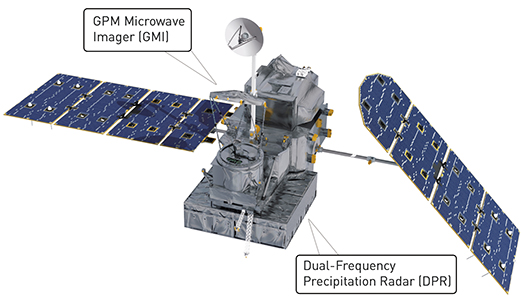 of the Ka-band radar improves the radar sensitivity so that weaker echoes are now detected. Another key instrument is the GPM Microwave Imager (GMI), which is a multi-channel, conically scanning, microwave radiometer with thirteen microwave channels ranging in frequency from 10 GHz to 183 GHz. The higher passive microwave frequencies are for the detection of snow. In addition to carrying channels similar to those on the Tropical Rainfall Measuring Mission (TRMM) Microwave Imager (TMI), the GMI carries four high frequency, millimeter-wave channels of 166 GHz and 183 GHz. With a 1.2 m diameter antenna, the GMI provides significantly improved spatial resolution over TMI. of the Ka-band radar improves the radar sensitivity so that weaker echoes are now detected. Another key instrument is the GPM Microwave Imager (GMI), which is a multi-channel, conically scanning, microwave radiometer with thirteen microwave channels ranging in frequency from 10 GHz to 183 GHz. The higher passive microwave frequencies are for the detection of snow. In addition to carrying channels similar to those on the Tropical Rainfall Measuring Mission (TRMM) Microwave Imager (TMI), the GMI carries four high frequency, millimeter-wave channels of 166 GHz and 183 GHz. With a 1.2 m diameter antenna, the GMI provides significantly improved spatial resolution over TMI.
|
 TRMM-related publications TRMM-related publications
| 
|


Houze, R. A.,
Jr., and C. A. Leary, 1976: Comparison of convective mass and heat
transports in tropical easterly waves computed
by two methods. J. Atmos. Sci., 33, 424-429.
Schumacher, C., and
R. A. Houze, Jr., 2000: Comparison of radar data from the TRMM satellite and Kwajalein oceanic validation site. J. Appl.
Meteor., 39, 2151-2164.

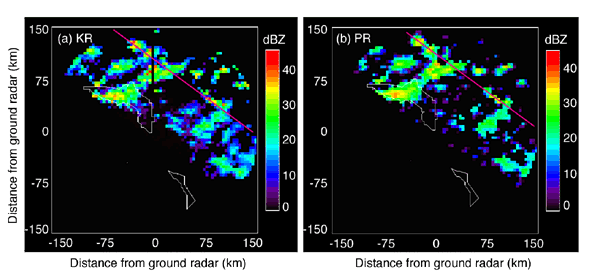 
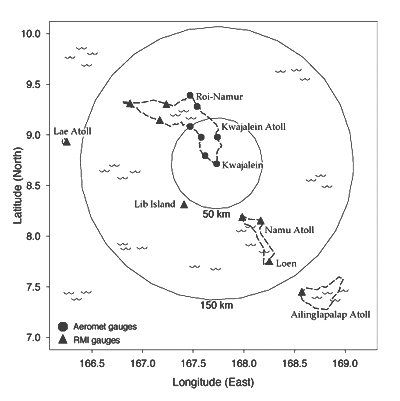
Schumacher, C., and R. A. Houze,
Jr., 2003a: Stratiform
rain in the tropics as seen by the TRMM Precipitation Radar. J.
Climate, 16, 1739-1756.

Schumacher, C., and R. A. Houze,
Jr., 2003b: The
TRMM Precipitation Radar’s view of shallow, isolated rain. J.
Appl. Meteor., 42, 1519-1524.
Houze, R. A., Jr., S. Brodzik, C. Schumacher,
S. E. Yuter, and C. R. Williams, 2004: Uncertainties
in oceanic radar rain maps at Kwajalein and implications for satellite
validation. J. Appl. Meteor., 43,
1114-1132.
Kim, M.-J., J. A. Weinman, and R. A. Houze,
Jr., 2004: Validation
of maritime rainfall retrievals from the TRMM-microwave radiometer. J.
Appl. Meteor., 43, 847-859.
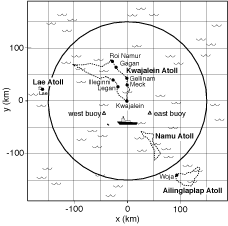
Yuter, S. E.,
R. A. Houze, Jr., E. A. Smith, T. T.Wilheit,
and E. Zipser, 2005: Physical
characterization of tropical oceanic convection observed in KWAJEX. J.
Appl. Meteor., 44, 385-415.
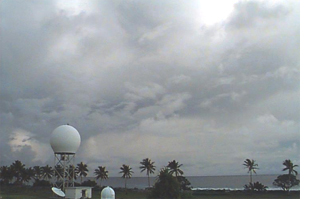
Cetrone, J.,
and R. A. Houze, Jr., 2006: Characteristics
of tropical convection over the ocean near Kwajalein. Mon.
Wea. Rev., 134,
834-853.
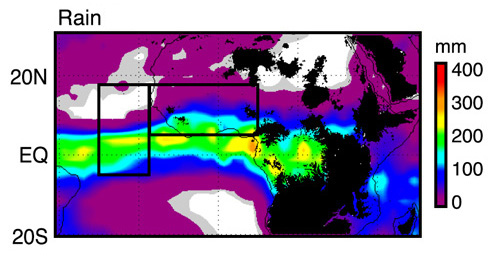
Schumacher, C., and R. A. Houze,
Jr., 2006: Stratiform
precipitation production over sub-Saharan Africa and the tropical East Atlantic as observed by TRMM. Quart. J. Roy. Meteor.
Soc., 132, 2235-2255.
Houze,
R. A., Jr., D. C. Wilton, and B. F. Smull, 2007: Monsoon
convection in the Himalayan region as seen by the TRMM Precipitation Radar. Quart.
J. Roy. Meteor. Soc., 133, 1389-1411.
Tao, W.-K., R. A. Houze,
Jr., and E. A. Smith, 2007: The fourth
TRMM latent heating workshop. Bull. Amer. Meteor. Soc., 88, 1255-1259.
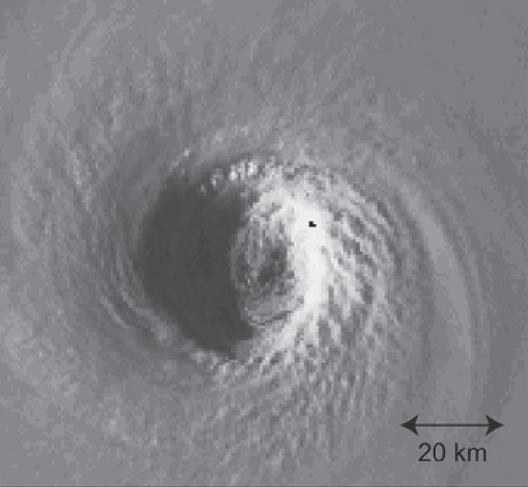 Houze, R. A., Jr.,
2010: Clouds in tropical cyclones. Mon.
Wea. Rev., 138, 293–344. Houze, R. A., Jr.,
2010: Clouds in tropical cyclones. Mon.
Wea. Rev., 138, 293–344.
Romatschke, U., S. Medina, and R. A. Houze, Jr., 2010: Regional, seasonal, and diurnal variations of extreme convection in the South Asian region. J. Climate, 23, 419-439.
Hence, D. A., and R. A. Houze, Jr.,
2011: Vertical structure of hurricane eyewalls as seen by the TRMM
Precipitation Radar. J. Atmos. Sci., 68, 1637-1652.
Rasmussen, K. L., and R. A. Houze,
Jr., 2011: Orogenic convection in South America as seen by the TRMM satellite. Mon. Wea. Rev., 139, 2399-2420.
Romatschke, U., and R. A. Houze, Jr., 2011: Characteristics of precipitating convective systems in the
premonsoon season of South Asia. J. Hydrometeorol.,12, 157-180.
Romatschke, U., and R. A. Houze, Jr., 2011: Characteristics of precipitating convective systems in the
South Asian monsoon. J. Hydrometeorol., 12, 3-26.
Hence, D. A., and R. A. Houze, Jr.,
2012: Vertical structure of tropical cyclones with concentric eyewalls as seen by the TRMM
Precipitation Radar. J. Atmos. Sci., 69, 1021-1036.

Hence, D. A., and R. A. Houze, Jr.,
2012: Vertical structure of tropical cyclone rainbands as seen by the TRMM Precipitation Radar. J. Atmos. Sci.,69, 2644–2661.
Houze, R. A., Jr., 2012: Orographic effects on precipitating clouds. Rev. Geophys., 50, RG1001, 47pp., doi:10.1029/2011RG000365.
Rasmussen, K. L., and R. A. Houze,
Jr., 2012: A flash flooding storm at the steep edge of high terrain: Disaster in the Himalayas. Bull. Amer. Meteor. Soc., 93, 1713-1724.
Barnes, H. C., and R. A. Houze,
Jr., 2013: The precipitating cloud population of the Madden-Julian Oscillation over the Indian and West Pacific Oceans. J. Geophys. Res., 118, 6996-7023, doi:10.1002/jgrd.50375.
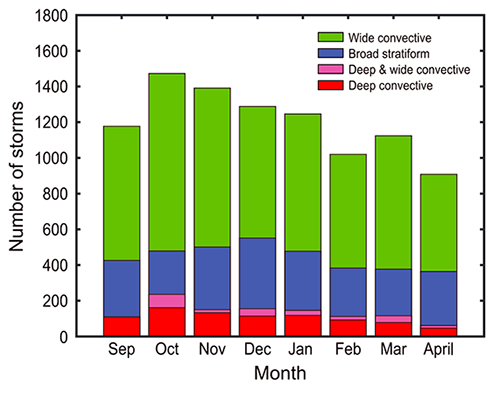 Rasmussen, K. L., S. L. Choi, M. D. Zuluaga, and R. A. Houze, Jr., 2013: TRMM precipitation bias in extreme storms in South America. Geo. Res. Lett., 40, 3457–3461, doi:10.1002/grl.50651. ("AGU Editors Research Spotlight" Precipitation underestimated in extreme storms in South America, EOS, Vol. 94, No. 35, 27 August 2013.) Rasmussen, K. L., S. L. Choi, M. D. Zuluaga, and R. A. Houze, Jr., 2013: TRMM precipitation bias in extreme storms in South America. Geo. Res. Lett., 40, 3457–3461, doi:10.1002/grl.50651. ("AGU Editors Research Spotlight" Precipitation underestimated in extreme storms in South America, EOS, Vol. 94, No. 35, 27 August 2013.)
Romatschke, U., and R. A. Houze,
Jr., 2013: Characteristics of precipitating convective systems accounting for the summer rainfall of tropical and subtropical South America. J. Hydrometeorol., 14, 25-46.
Viale, M., K. L. Rasmussen, and R. A. Houze,
Jr., 2013: Upstream orographic enhancement of a narrow cold-frontal rainband approaching the Andes. Mon. Wea. Rev., 141, 1708-1730.
Rasmussen, K. L., M. D. Zuluaga, and R. A. Houze Jr., 2014: Severe convection and lightning in subtropical South America. Geophys. Res. Lett., 41, 7359–7366, doi:10.1002/2014GL061767. Featured cover. ("AGU Editors Research Spotlight" What causes extreme hail, tornadoes, and floods in South America?, EOS, Vol. 96, 11 May 2015.)
 Powell, S. W., and R. A. Houze, Jr., 2015: Evolution of precipitation and convective echo top heights observed by TRMM radar over the Indian Ocean during DYNAMO. J. Geophys. Res. Atmos., 120, 3906–3919, doi:10.1002/2014JD022934. Powell, S. W., and R. A. Houze, Jr., 2015: Evolution of precipitation and convective echo top heights observed by TRMM radar over the Indian Ocean during DYNAMO. J. Geophys. Res. Atmos., 120, 3906–3919, doi:10.1002/2014JD022934.
Rasmussen, K. L., A. J. Hill, V. E. Toma, M. D. Zuluaga, P. J. Webster, and R. A. Houze,
Jr., 2015: Multiscale analysis of three consecutive years of anomalous flooding in Pakistan. Quart.
J. Roy. Meteor. Soc., 141, 1259–1276, doi:10.1002/qj.2433.
Zuluaga, M. D., and R. A. Houze,
Jr., 2015: Extreme convection of the near-equatorial Americas, Africa, and adjoining oceans as seen by TRMM. Mon. Wea. Rev., 143, 298-316.
Rasmussen, K. L., M. M. Chaplin, M. D. Zuluaga, and R. A. Houze, Jr., 2016: Contribution of extreme convective storms to rainfall in South America. J. Hydrometeorol., 17, 353-367.
|
 GPM-related publications GPM-related publications
| 
|

Coming soon
| |